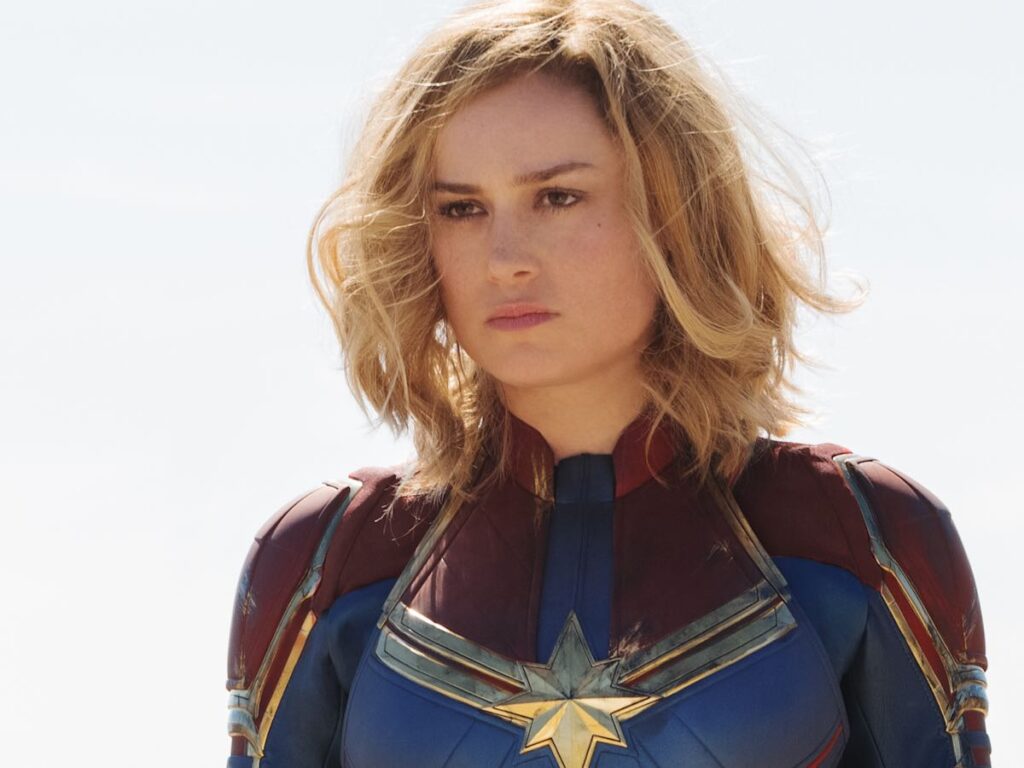In many ways, one can consider Captain Marvel (2019) as an artistic product thoroughly defined by its circumstances. In 2019, two years after the release of Wonder Woman (2017) by WB and DC, the MCU had yet to make a film with a female superhero as the lead. Despite having an impressive roster of heroines like Black Widow, Gamora and Scarlet Witch, there was a conceivable gap as far as an invincible superheroine, who could go toe to toe with the likes of Thor and Thanos, was concerned. On top of that, Avengers: Endgame, arguably MCU’s biggest release till date, was slated to open soon. In these circumstances, Captain Marvel found itself telling an origin story set in the 90s for one of the most powerful heroes in the Marvel universe.
Telling an engrossing story about the creation of an iconic character with no prior introduction, right before the culmination of the events of an entire cinematic saga was a considerable risk. Even though Captain Marvel had been a fairly prominent character in the Marvel comic books, she had virtually no mention or presence in the films leading up to Avengers: Infinity War, Endgame’s predecessor. Directors Anna Boden and Ryan Fleck wrote Captain Marvel’s screenplay along with Geneva Robertson Dworet in such a way that it introduced the titular character, as well as explained her absence from the events of the films until then.
Let’s take a look at the screenplay of Captain Marvel, and how it addresses these questions.
Superhero films in general, and MCU origin films in particular follow the traditional three-act structure: set-up in the first act, confrontation in the second, and resolution in the final act. The story is usually driven along by the plot which focuses around whether or not the protagonist will be able to accomplish what they set out to do, or overcome the bad guys against them. Captain Marvel follows the three-act structure, but does not adhere to the templates of MCU’s origin stories. Instead of a straightforward “hero gains powers, saves the day” flick, the film plays out like a high-action detective story, where the audience witnesses the construction of the hero’s identity.
Act One: The Set Up

Captain Marvel begins on the planet of Hala, home to the Kree civilization. Through Vers (Brie Larson), we are told that the Kree are a technologically advanced race who are in the middle of an intergalactic war with the Skrulls, a race of supposed terrorists and invaders. We are also informed that the Kree are ruled by a collective consciousness known as the Supreme Intelligence, who appears to each Kree differently, taking on the form of someone significant in their lives. To Vers, it appears as Dr Wendy Lawson (Annette Benning).
Later on, as they leave for a mission to the planet of Torfa, we get to see the militarization of the planet, and the depth of their mission against the Skrulls. As she escapes, the action shifts to Earth, where she meets Nick Fury (Samuel L. Jackson), escapes from Skrulls and finds more missing pieces that lead her to her past.
Key Takeaways
Since the first act of an origin film is generally used to provide exposition regarding the characters and their surroundings, Captain Marvel does, more or less, the same. It establishes the heroine in her milieu and gives us a rough idea of who to root for. By showing us a quick skirmish with the Skrulls, it also cements the idea in our minds that the Skrulls are supposed to be the antagonists. What is truly interesting about the first act in the film is that it does not dump information on the viewers. Rather, keeping in mind the themes of the film, it tantalizingly dangles fragments of Vers’ past in front of her as well as the audience. This is a solid writing choice that allows the film to escape the trap of mindless exposition. Show, not tell is generally a good rule of thumb when it comes to storytelling, and the first act of the film is a great example.
The first act of the film, unlike superhero films, does not have to do with Vers gaining her powers. She begins her journey completely empowered. Rather, the set-up has to do with a search for answers and self-knowledge. The idea is to let the characters as well as the audience discover Vers as an individual, and not just a Kree soldier. Vers’ has no idea where she comes from, or who she is. By establishing her as a novice, the story creates a bond between the viewer and Vers. Like us, she doesn’t know much about Hala, The Kree or the Skrulls. The set-up also foreshadows the major themes of the film about identity. It invites us to make assumptions about the nobility of the Kree, simply because we have been shown their viewpoint so far. Hence, as the action progresses, the viewer is given cues that all is not as it seems, through bits and pieces of Vers’ past. The writing creates a link between past and present that causes the audience to actively question what is being shown on the screen, and root for Vers to discover more.
Act Two: The Confrontation
Upon finding out information about Project Pegasus, with which both Vers and Lawson were involved, Fury and Vers are pursued by S.H.I.E.L.D Agents led by a Skrull in disguise named Talos. They escape and fly to Louisiana, to find Maria Rambeau, a friend from Vers’ past and get answers. After a tense confrontation with Rambeau, Talos and Vers, we find out that Vers is actually Carol Danvers, who was an American pilot testing Lawson’s projects with the Tesseract. Apparently, both of them died in an unauthorized air crash. It is also revealed that Carol is not Kree, and her powers were a result of the crash when she absorbed the power source. Upon finding this, Carol decides to help the Skrulls find the energy core and a new home.
Key Takeaways
This part does not so much deal with Carol learning to use her powers, as it does with subverting expectations and tropes. Audiences were mistakenly led to believe that the Skrulls are the antagonists, and the Kree are the noble heroes. But, by placing the Skrulls as someone we should empathize with, the film forces Carol and us to reexamine biases. While the second act of the film revolves around the protagonist learning to use their powers, Captain Marvel takes a different approach. It is a film deeply informed by identity and self-knowledge. Carol’s powers are not the problem here, they have already been established. But her weakness in the first act was her self-doubt, and her ignorance regarding her past. Upon finding out that she had a life on Earth, and gained powers from the Tesseract, and not the Kree, Carol is no longer facing a lacuna in her narrative. This figurative completion allows her to fully embrace her potential, and aids in her character development. Her knowledge about herself and who she is becomes her new power.

As Carol struggles to accept the truth and break out of her Kree conditioning, we confront the fact that the Kree lied to her and kept the knowledge of her powers secret. By causing a recontextualization of all that we have been told so far, the film causes Carol to come to terms with her identity, something that she had been struggling with since the first act.
This act also does a lot of heavy-lifting in terms of setting up emotional pay-offs. Carol might be nearly indestructible, but her new allies are not. By introducing Nick, Maria and the family of Skrulls, the film ups the narrative’s stakes, as we are actively rooting for them to make it out unscathed. It also establishes Carol firmly as one of the good guys, right before the climactic outer-space fight.
Act Three: The Resolution
As with most Marvel films, the climax is a blow-out, no holds barred fight between the good guys and the Kree colonizers. Yon-Rogg arrives with reinforcements and takes the Skrulls, Nick and Maria captive. Carol is taken to commune with the Supreme Intelligence. Armed with her new knowledge, she breaks free and defeats her captors. Managing to escape, she teams up with Nick and Maria and devises a plan to get the Skrulls to safety. As Ronan arrives to attack Earth, Carol dismantles multiple warheads in an impressive display of her might, prompting him to call off the attack.

In a final showdown with Yon-Rogg, Carol refuses to fight him, saying she has nothing to prove to him, and walks away, sending him back to Hala as a warning. This is a great payoff from the beginning of the film, where he tries to bait her into fighting him without her powers, preying on her self-doubt. As Carol fully breaks out of Kree conditioning, it signifies her complete freedom and refusal to answer to anyone but herself. Her refusal is a satisfying climactic moment, as it signals her growth and confidence. The film makes use of subtle metaphors of gaslighting, and watching Carol refusing to engage with someone who was mentally abusive and manipulative to her is extremely gratifying.
Key Takeaways
The key takeaways from this chapter are not so much concerned with plot advancement, rather a satisfying thematic conclusion. As one of the most powerful heroes in the universe, Carol is never really in harm’s way. So, the film does not focus on her winning a fight, or beating up bad guys. Rather, the focus is on her completing a journey of self-discovery, and finding a purpose. By finding the answers to her past, she is able to envision a new purpose for herself as one of the universe’s protectors.
As she pledges to help the Skrulls all over the galaxy, and bids goodbye to Maria and Nick, she has come a long way from the lost warrior in the beginning of the film, to a fully developed, self-aware character.
In the end, Carol’s victory is realizing her full potential, and leaving behind an oppressive system to be truly free. It is this blend of high-octane action and a fitting emotional catharsis that truly brings together the themes of the film. As satisfying as it is to watch Carol turn into a one-woman army and take down spaceships by simply flying through them, the true core of the film lies in the solid character development that effectively find a medium to tell a relatable, and heartwarming story about intergalactic fights in space, as well as finding the will and knowledge to empower oneself.




